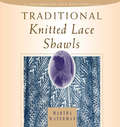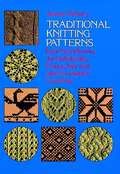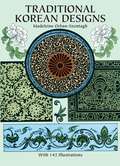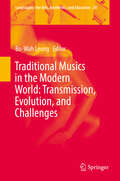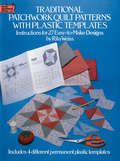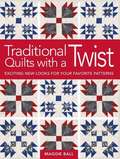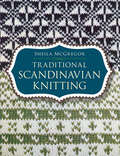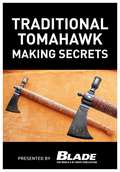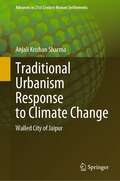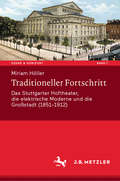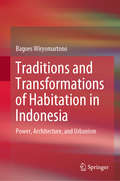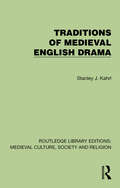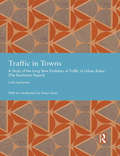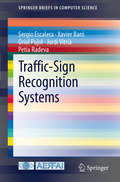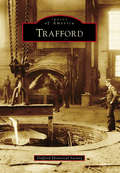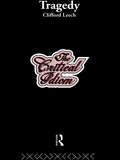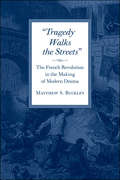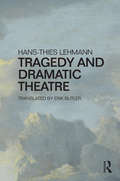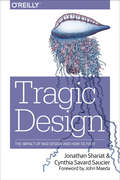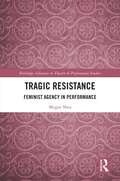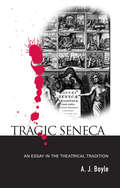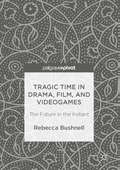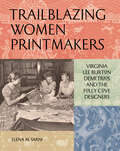- Table View
- List View
Traditional Knitted Lace Shawls
by Martha Waterman NicholsTimeless and beautiful shawls from Ireland, Scotland, and Wales in an array of shapes with openwork, textured stitches, and lace edgings. Everything you need to know to design and knit your own shawls is provided.
Traditional Knitting Patterns: from Scandinavia, the British Isles, France, Italy and Other European Countries
by James NorburyIn this book you will find 263 different patterns and designs, the best traditional knitting material from the Arabic, Spanish, Italian, French, German, Austrian, Dutch, Scandinavian, Shetland, English, Scottish, and Irish knitting traditions. All are presented clearly so you can use them immediately in your own work, or use them for learning how knitting developed the world over.In an easy-to-use format, the patterns and designs are first presented according to country. Then, after a short introduction discussing characteristic patterns, backgrounds, and influences, the author presents groupings of folk designs and traditional patterns. Each pattern and design is accompanied by a photograph of the completed work and either a chart or carefully written out instructions showing how to work the patterns. Since designs and patterns are given for characteristic units that can be repeated, you can use these patterns for projects of all sizes and shapes as well as for individual motifs. With a little planning these patterns can be used successfully for a wide range of knitting needs.Knitters can use this book for learning exciting knitting traditions and for picking up new motifs and designs. In looking through the patterns and designs you will see how new ideas sprang up and how others were carried from culture to culture. But most importantly you will have on hand 256 different patterns, some of the most powerful folk material the knitter can have. The author's clear instructions can be followed by anyone who practices basic knitting.
Traditional Korean Designs (Dover Design Library)
by Madeleine Orban-Szontagh142 bold black-and-white line drawings inspired by authentic Korean arts and crafts dating from the 1st through the 19th centuries, ranging from full- and half-page motifs to borders, panels, medallions, and all-over patterns, and from abstract forms to realistic depictions of costumed figures, birds, flowers, and landscapes. Royalty-free.
Traditional Musics in the Modern World: Transmission, Evolution, and Challenges (Landscapes: the Arts, Aesthetics, and Education #24)
by Bo-Wah LeungThis book reviews the current practices of traditional musics in various cultures of all continents, and examines the impact and significance of traditional musics in the modern world. A diverse group of experts of musicology and music education collaborate to expose the current practices and challenges of transmission and evolution of traditional musics in order to seek sustainable development, so that traditional musics can take the place they deserve in the modern world and continue to contribute to human civilization. This volume contains three main sections that include transmission of traditional musics, authenticity and evolution, as well as challenges in future. Based on the chapters, the editor proposes four major trends of transmission of traditional musics, namely, formalization, politicization, Westernization and modernization in transforming contexts.
Traditional Patchwork Quilt Patterns with Plastic Templates: Instructions for 27 Easy-to-Make Designs
by Rita WeissNo more scaling up of blocks. No more tracing patterns. No more gluing designs onto sandpaper or cardboard. Patchwork quilting has never been easier, thanks to the special feature of this volume -- permanent plastic templates.From the four easy-to-use templates provided, needleworkers can create 27 of the most popular patchwork patterns, using traditional handsewing techniques or the sewing machine. Choose from such authentic favorites as Windmill, Susannah, Road to Oklahoma, Stars and Stripes, Puss-in-the-Corner, Ohio Star, Dutchman's Puzzle, Martha Washington's Star, and others. Selected for their relative simplicity, the motifs are still intriguing enough to provide challenges for both beginners and experts.Use the blocks together to create stunning sample quilts, or repeat a single block over and over again for a striking one-design quilt. Many of these blocks produce wonderful optical illusions when an entire quilt is made of the same block. For equally eye-catching results, try repeating two or three different blocks in one quilt. The number of quilts you can make with this volume is virtually limitless!Colors have not been specified for the quilt blocks, but noted needlecraft designer Rita Weiss has indicated light, bright, medium, and dark fabrics as guideposts. Let your imagination dictate your own color scheme and achieve beautiful one-of-a-kind quilts that reflect your unique personality and creativity. You'll find 59 helpful illustrations, plus complete instructions for using the templates, material selection, cutting, sewing -- everything needed for successful quilt-making.Traditional Patchwork Quilt Patterns with Plastic Templates will inspire needleworkers at all levels of expertise. Now you can produce inexpensive, toasty warm, colorful bed coverings that will add distinctive period charm to every bedroom in the house.
Traditional Quilts with a Twist
by Maggie BallBreathe New Life into your Favorite Traditional Blocks Take the Ohio Star, Trip Around the World and Bear's Paw blocks from "been there and done that" to fresh and fabulous new heights withTraditional Quilts with a Twist. Author Maggie Ball gives these blocks a modern makeover and teaches you how to tweak the designs with the right colors, fabric choices, value placements and settings to bring a spotlight-grabbing twist to your favorite blocks. Traditional Quilts with a Twistgives you: Comprehensive instructions for quilting basics Patterns that progress from easy to challenging 20 projects in various types and sizes, ranging from tote bags to queen-size quilts Clear, concise instructions accompanied by full-color photos and illustrations You'll fall in love - again - with the time-tested favorite blocks inTraditional Quilts with a Twist.
Traditional Scandinavian Knitting
by Sheila McgregorAn expert on traditional Scandinavian knitting explains the distinctive craft's origins, its various types, and knitting techniques in this classic guide. Sheila McGregor's in-depth treatment ranges from the regional styles of Norway, Sweden, and Denmark to those of the North Atlantic Islands of Faeroe and Iceland. Vibrant patterns for an array of garments include jerseys, gloves and mittens, stockings, and caps. Illustrated with 191 black-and-white and 20 color pictures, this volume is well known and prized among longtime practitioners of the craft. Its return to print will delight a new generation of knitting enthusiasts.
Traditional Tomahawk Making Secrets
by Joe KertzmanLearn how Native Americans and early blade smiths fashioned the fierce and fantastic tomahawk. There are fewer cool edged weapons on the planet, says author Joe Szilaski, a regular contributor to BLADE® Magazine and an accomplished knife and tomahawk maker.
Traditional Urbanism Response to Climate Change: Walled City of Jaipur (Advances in 21st Century Human Settlements)
by Anjali Krishan SharmaThe book focuses on the key contemporary issue of Climate change, constructing the narrative from traditions’ of Urbanism through its Axiology and Epistemology. The book is a rich collection of seven chapters and attempts to address each of the aspects and building further for traditional Urbanism. The book further explores the synergies of traditional urbanism for Climate change through climate responsive practices with main thrust on Energy use. The said understanding is validated through the case example of walled city of Jaipur: World Heritage Site 2019. The chapters enumerate how the traditional urbanism of Jaipur was designed that evolved as climate responsive typology for the respective geography.
Traditioneller Fortschritt: Das Stuttgarter Hoftheater, die elektrische Moderne und die Großstadt (1851-1912) (Szene & Horizont. Theaterwissenschaftliche Studien #7)
by Miriam HöllerDie Studie über das Stuttgarter Hoftheater denkt Theater und Stadt zur Zeit der Elektrifizierung um 1900 zusammen. Welchen Einfluss hatte die Theatertechnik auf die werdende Großstadt? Wie wurde umgekehrt das Theater durch die Urbanisierung und Technisierung der Stadt geprägt? Die Studie untersucht anhand historischer Quellen diese Wechselbeziehung über die Analyse neuer räumlich-materieller Vernetzungen. Außerdem analysiert sie kollektive Großstadt-Imaginationen, die zwischen 1902 und 1912 bei der Planung eines Theaterneubaus in Stuttgart aufkamen und die insbesondere über die Architektur und Technik des Theaters verhandelt wurden. Zentral war dabei eine Aushandlung im Spannungsfeld von Tradition und Moderne. So zeigt die Studie, dass auch ein Hoftheater fern der Metropolen als Ort der Moderne erfahren werden konnte, und leistet somit am Schnittpunkt von Theater-, Technik-, Stadt- und Kulturgeschichte einen Beitrag zur Erforschung der Vielfalt des deutschen Theaters um 1900.
Traditions and Transformations of Habitation in Indonesia: Power, Architecture, and Urbanism
by Bagoes WiryomartonoThis book raises the issue of the practice of patrimonial power with a focus on habitations, particularly in the urban areas of Indonesia. An assemblage of interdisciplinary studies within the framework of environmental humanities, covering the arts, architecture, urban studies, geography, cultural anthropology, and sociology, this multifaceted framework divulges the interactive connectivity between Indonesia’s patrimonial culture and the socio-culturally constructed system of habitation. The interdisciplinary study of the pertinent practices of patrimonial power that have been represented and been manifested by various political and traditional regimes in terms of the built environment and habitation in Indonesia contributes to a new understanding of Indonesian urban spatial development, from the pre-colonial era to the present. The book poses that in order to understand the politics of Indonesia, one must understand the culture and tradition of the political leadership of the country. The author presents such an understanding in exploring and unpacking the relationship between people and place that constructs, develops, sustains, and conserves Indonesian culture and traditions of habitation. This book is of interest to graduate scholars and researchers in Asian Studies in numerous disciplines, including urban studies, urban planning and design, political science, architecture, anthropology of space, public administration, and political philosophy.
Traditions of Medieval English Drama (Routledge Library Editions: Medieval Culture, Society, & Religion)
by Stanley J. KahrlOriginally published in 1974, this book examines in detail some of the finest plays from the great cycles of York, Wakefield and Chester. By considering the plays as plays rather than literary relics of a past age, he throws new light both on their aims and intentions as drama and on the intriguing problems of stage techniques. The major morality plays of the period are discussed not only for the interest of their content but for their effectiveness as theatre. Throughout the book the author stresses the richness and strength of a drama which, despite its small corpus of plays, survived as popular drama for several hundred years.
Traffic in Towns: A Study of the Long Term Problems of Traffic in Urban Areas (Studies in International Planning History)
by Colin BuchananTraffic in Towns, also known as the Buchanan Report, is regarded as one of the most influential planning documents of the twentieth century. The report reflected mounting concern about the impact on Britain’s towns and cities of rapid growth in the ownership and use of motor vehicles. Its purpose was to evaluate policy options for reducing the threat of traffic congestion to urban circulation and quality of life. Two main conclusions were drawn from the report: firstly, the need for large-scale reconstruction to make Britain’s cities fit for the ‘motor age’, including split-level megastructures and urban motorways; and secondly, the simultaneous need to preserve parts of the city, especially residential areas as car-free zones or ‘environmental areas’. In Britain, successive governments drew back from implementing the full recommendations of the Study Group, despite initial cross-party support. The prohibitive cost of city-centre redevelopment and motorway construction meant a ‘comprehensive’ solution to the problem of urban traffic on Buchanan lines was never attempted. However, local authorities in a variety of British cities, such as Glasgow, Leicester and Leeds took up aspects of the Report. Internationally, too, the Report had a major impact in countries such as Sweden, Italy and Australia. In the longer term, the influence of the Report may be best judged by the incremental changes it set in train such as pedestrianization of city centres, traffic calming, and other measures linked to Buchanan’s concept of ‘environmental areas’. In focusing attention on the effects of mass motorization on the urban environment Traffic in Towns set the terms of debate for a generation, pre-figuring recent discussion about the car and urban sustainability.
Traffic-Sign Recognition Systems
by Petia Radeva Jordi Vitrià Xavier Baró Oriol Pujol Sergio EscaleraThis work presents a full generic approach to the detection and recognition of traffic signs. The approach is based on the latest computer vision methods for object detection, and on powerful methods for multiclass classification. The challenge was to robustly detect a set of different sign classes in real time, and to classify each detected sign into a large, extensible set of classes. To address this challenge, several state-of-the-art methods were developed that can be used for different recognition problems. Following an introduction to the problems of traffic sign detection and categorization, the text focuses on the problem of detection, and presents recent developments in this field. The text then surveys a specific methodology for the problem of traffic sign categorization - Error-Correcting Output Codes - and presents several algorithms, performing experimental validation on a mobile mapping application. The work ends with a discussion on future research and continuing challenges.
Trafford (Images of America)
by Trafford Historical SocietyTrafford, located in the hills east of Pittsburgh, was officially incorporated as a borough in 1904. John Cavett I and his family were among the first settlers in the area, after purchasing land in 1769. Tracks for the Pennsylvania Railroad were laid through in 1852, and the territory became known as Stewart Station. In 1902, land at Stewart Station was purchased by renowned entrepreneur George Westinghouse, with the purpose of constructing a foundry and town to be named Trafford City, after Trafford Park in Manchester, England. Western Pennsylvania newspapers advertised the sale of lots in Trafford City, and thousands of property seekers came pouring in. The plant thrived for the majority of the 20th century and was the key to Trafford’s growth as a borough. Today, with the plant long gone, Trafford survives as a quaint, community-oriented town with an industrial history that all Pittsburghers can appreciate.
Tragedy (The\critical Idiom Reissued Ser. #1)
by Clifford LeechProfessor Leech considers the significance of the term ‘Tragedy’ as it has been used from classical times to the present day. He gives examples of tragic writing from a wide variety of dramatic literatures and relates theoretical writings on tragedy and the tragedies that have been contemporaneous with them. Free reference is made to critics from Aristotle to these of the present. Special stress is laid on the tragedies of the Greeks, of Renaissance writers and of our immediate contemporaries, notably Harold Pinter and Tom Stoppard. There is also discussion of tragic writing in the modern novel.
Tragedy Walks the Streets: The French Revolution in the Making of Modern Drama
by Matthew S. BuckleyTragedy Walks the Streets challenges the conventional understanding that the evolution of European drama effectively came to a halt during France's Revolutionary era. In this interdisciplinary history on the emergence of modern drama in European culture, Matthew S. Buckley contends that the political theatricality of the Revolution tested and forced the evolution of dramatic forms, supplanting the theater itself as the primary stage of formal development. Drawing on a wide range of texts and images, he demonstrates how the social and political enlistment of dramatic theatricality inflected rising social and political tensions in pre-Revolutionary France, shaped French Revolutionary political culture, conditioned British political and cultural responses to the Revolution, and served as the impetus for Büchner’s radical formal innovations of the 1830s. Setting aside traditional boundaries of literary scholarship, Buckley pursues instead a history of dramatic form that encompasses the full range of dramatic activity in the changing cultural life of the late eighteenth and early nineteenth century, including art, architecture, journalism, political performance, and social behavior. Surveying this expanded field of inquiry, Buckley weaves together a coherent formal genealogy of the drama during this period and offers a new, more continuous generic history of modern drama in its first and most turbulent phase of development.
Tragedy and Dramatic Theatre
by Hans-Thies LehmannThis comprehensive, authoritative account of tragedy is the culmination of Hans-Thies Lehmann’s groundbreaking contributions to theatre and performance scholarship. It is a major milestone in our understanding of this core foundation of the dramatic arts. From the philosophical roots and theories of tragedy, through its inextricable relationship with drama, to its impact upon post-dramatic forms, this is the definitive work in its field. Lehmann plots a course through the history of dramatic thought, taking in Aristotle, Plato, Seneca, Nietzsche, Heidegger, Lacan, Shakespeare, Schiller, Holderlin, Wagner, Maeterlinck, Yeats, Brecht, Kantor, Heiner Müller and Sarah Kane.
Tragic Design: The Impact of Bad Product Design and How to Fix It
by Cynthia Savard Saucier Jonathan ShariatBad design is everywhere, and its cost is much higher than we think. In this thought-provoking book, authors Jonathan Shariat and Cynthia Savard Saucier explain how poorly designed products can anger, sadden, exclude, and even kill people who use them. The designers responsible certainly didn’t intend harm, so what can you do to avoid making similar mistakes?Tragic Design examines real case studies that show how certain design choices adversely affected users, and includes in-depth interviews with authorities in the design industry. Pick up this book and learn how you can be an agent of change in the design community and at your company.You’ll explore:Designs that can kill, including the bad interface that doomed a young cancer patientDesigns that anger, through impolite technology and dark patternsHow design can inadvertently cause emotional painDesigns that exclude people through lack of accessibility, diversity, and justiceHow to advocate for ethical design when it isn’t easy to do soTools and techniques that can help you avoid harmful design decisionsInspiring professionals who use design to improve our world
Tragic Muse
by Rachel BrownsteinThe great nineteenth-century tragedienne known simply as Rachel was the first dramatic actress to achieve international fame. Composing her own persona with the same brilliance and passion she demonstrated on stage, she virtually invented the role of "star. " Rumors of her extravagant life offstage delighted the audiences who flocked to theaters in Boston and Paris, London and Moscow, to see her perform in the tragedies of Racine and Corneille. InTragic Muse, Rachel M. Brownstein reveals the life ofla grande Racheland explores—at the boundary of biography, fiction, and cultural history—the connections between this self-dramatizing woman and her image. Born to itinerant Jewish peddlers in 1821, Rachel arrived on the Paris stage at the age of fifteen. She became both a symbol of her culture’s highest art and a clue to its values and obsessions. Fascinated with all things Napoleonic, she was the mother of Napoleon’s grandson and the lover of many men connected to the emperor. Her story—the rise from humble beginnings to queen of the French state theater—echoes and parodies Napoleon’s own. She decisively controlled her career, her time, and finances despite the actions and claims of managers, suitors, and lovers. A woman of exceptional charisma, Rachel embodied contradiction and paradox. She captured the attention of her time and was memorialized in the works of Matthew Arnold, Charlotte Brontë, George Eliot, and Henry James. Richly illustrated with portraits, photographs, and caricatures,Tragic Musecombines brilliant literary analysis and exceptional historical research. With great skill and acuity, Rachel M. Brownstein presents Rachel—her brief intense life and the image that was both self-fashioned and, outliving her, fashioned by others. First published by Knopf (1993), this book will attract a broad audience interested in matters as wide ranging as the construction of character, the cult of celebrity, women’s lives, and Jewish history. It will also be of enduring interest to readers concerned with nineteenth-century French culture, history, literature, theater, and Romanticism. Tragic Musewon the 1993 George Freedley Award presented by the Theater Library Association.
Tragic Resistance: Feminist Agency in Performance (Routledge Advances in Theatre & Performance Studies)
by Megan SheaTragic Resistance analyzes playwrights, directors, and performers who shatter gender norms to gain agency within the patriarchal institutions restricting them.The artists in this book work against the tragic narratives that would otherwise constrict them: the tragedy of Antigone unmade by Judith Malina, the history of "The Venus Hottentot" pulled into the present in Suzan-Lori Parks's Venus, the narrative of the rape "victim" eschewed in Emma Sulkowicz's performances, the story of brides jilted by the homophobic state government in the case of Annie Sprinkle and Beth Stephens, the tragedy of Anna Nicole as told by Margaret Cho, and the reclamation of the female body from traditional hip hop by Nicki Minaj. All these performers and performances subvert traditional notions of gendered roles that people should or could hold.This book examines the nature of these performances to interrogate how theatrical and performative resistance works and why performance might be a vehicle for altering patriarchal structures that withhold agency from women and trans/genderqueer+ people.
Tragic Seneca: An Essay in the Theatrical Tradition
by A. J. BoyleTragic Seneca undertakes a radical re-evaluation of Seneca's plays, their relationship to Roman imperial culture and their instrumental role in the evolution of the European theatrical tradition.Following an introduction on the history of the Roman theatre, the book provides a dramatic and cultural critique of the whole of Seneca's corpus, analysing the declamatory form of the plays, their rhetoric, interiority, stagecraft and spectacle, dramatic, ideological and moral structure and their overt theatricality. Each of Seneca's plays is examined in detail, locating the force of Senecan drama not only in the moral complexity of the texts and their representations of power, violence, history, suffering and the self, but the semiotic interplay of text, tradition and culture.The later chapters focus on Seneca's influence on Italian, English and French drama of the Renaissance. A.J. Boyle argues that tragedians such as Cinthio, Kyd, Marlowe, Shakespeare, Webster, Corneille, and Racine owe a debt to Seneca that goes beyond allusion, dramatic form and the treatment of tyranny and revenge to the development of the tragic sensibility and the metatheatrical mind.Tragic Seneca attempts to restore Seneca to a central position in the European literary tradition. It will provide readers and directors of Seneca's plays with the essential critical guide to their intellectual, cultural and dramatic complexity.
Tragic Time in Drama, Film, and Videogames
by Rebecca BushnellThis book explores how classical and Shakespearean tragedy has shaped the temporality of crisis on the stage and in time-travel films and videogames. In turn, it uncovers how performance and new media can challenge common assumptions about tragic causality and fate. Traditional tragedies may present us with a present when a calamity is staged, a decisive moment in which everything changes. However, modern performance, adaptation and new media can question the premises of that kind of present crisis and its fatality. By offering replays or alternative endings, experimental theatre, adaptation, time travel films and videogames reinvent the tragic experience of irreversible present time. This book offers the reader a fresh understanding of tragic character and agency through these new media's exposure of the genre's deep structure.
Trailblazing Women Printmakers: Virginia Lee Burton Demetrios and the Folly Cove Designers
by Elena M. SarniA visual history of the Folly Cove Designers (1941-1969)—one of America's longest-running block printing collectives.The Folly Cove Designers (officially 1941-1969) was a grassroots collective of predominantly women block printers founded by Caldecott Award-winner and beloved children's book author/illustrator Virginia Lee Burton Demetrios (of Mike Mulligan and His Steam Shovel fame).This trailblazing Gloucester, MA–based group produced more than three hundred distinct designs, which they block printed on fabric. The designs conveyed personal and regional narratives through the use of shared design principles and the compelling language of pattern. The group was propelled to international fame through commercial contracts with major retailers (F. Schumacher, Lord & Taylor, etc.), articles in leading periodicals such as Life, and participation in seminal fine craft exhibitions. Their work continues to inspire contemporary printmakers around the globe, particularly women printmakers.As the first comprehensive history of the Folly Cove Designers, Trailblazing Women Printmakers documents and celebrates the group's tremendous success and the incredible artistry of its members. With more than 250 black-and-white and color photographs, author Elena M. Sarni explores the Folly Cove Designers' history, work, and group dynamics.
Trailerama: 1000 Piece Puzzle
by Phil NoyesPhotos, postcards, and ads featuring vintage trailers—from humble family vacations to Hollywood stars. Trailerama provides a visual wonderland filled with imagery featuring these vintage vehicles, fondly recalled for their associations with fun, adventure, family vacations—and of course, movie stars on the set. From greeting cards to postcards to Hollywood photos, the travel trailer is put on grand display in this kitschy celebration culled from the coffers of Trailer Travel&’s Phil Noyes. &“Filled with colorful images of trailers. Culled from ads, postcards, sheet music, and more, they run the gamut from the earliest mobile coaches in the 1930s to the roving behemoths that came to dominate the market in later decades…Noyes documents the country&’s still smoldering love affair with life on the road.&”—Los Angeles Magazine
